
 |
A•dōnꞋis
— from Semitic: TheraꞋ 𐤀𐤃𐤍 Hebrew אָדוֹן Greek physicomorphic (anthropomorphic) idol.
According to the myth, A•dōnꞋis was killed by a pig during a hunting trip and died in the arms of weeping Aphrodite. Her tears, the myth goes, mingled with his blood and he reincarnated as the red anemone flower. Thus, in modern times A•dōnꞋis has been widely perceived as a prime example of the archetypal mortally-dying-then-mortally-resurrected gōd.

 216x300.jpg) |
Ãl•lãhꞋ Arab Animism & Anthropomorphism ![]() — There is no credible dispute among historians that
— There is no credible dispute among historians that Al•lãtꞋ, fem. goddess counterpart of Al•lahꞋ; was an Arabian chief goddess of Mecca, the Arab equivalent of A•shᵊr•ãhꞋ and Ash•tōrꞋët and the pre-Islamic consort of Al•lahꞋ. This implacably precludes any argument that Al•lahꞋ was not a pre-Islamic idol!!!
While Muhammad ordered her idol and temple in Taif (100km east of Mecca) demolished in a commendable general effort to eliminate idolatry among Arabs, he salvaged her temple in Mecca—removing her idol (to his credit)—into today's Kaaba!
Al•lãtꞋ equates to the Hellenist Greeks' Athena (goddess of wisdom and war; daughter of Ζεύς, Hellenist Greek Aphrodite (goddess of love and sex; also a daughter of Ζεύς), equating to Ash•tōrꞋët, as well as Hãt-HōrꞋ and Ash•tōrꞋët.

 |
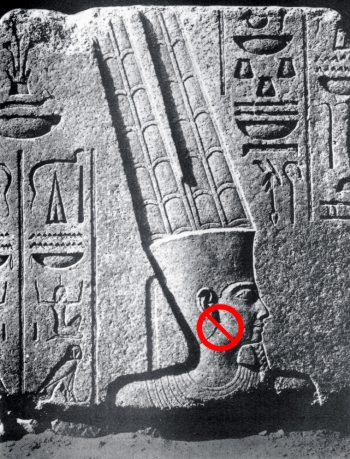 |
ÕmūnꞋ ("invisible god") Egyptian Animism & Anthropomorphism ![]() — , originally depicted as a man wearing two ostrich plumes as a headdress and carrying the ankʰ and Wãss scepter.
— , originally depicted as a man wearing two ostrich plumes as a headdress and carrying the ankʰ and Wãss scepter.
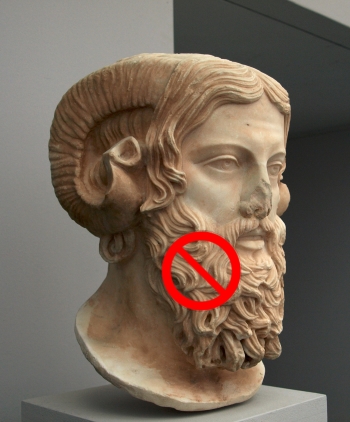 |
Amun was husband of Amunet (fem. of Amun, meaning "invisible goddess"; equating to WōsꞋrët, who in turn equated, via IꞋsis, to the Arabs' Al•latꞋ goddess, wife of Al•lahꞋ).
Perceived by Egyptians to be the Chief God and King of Gods, Amun required men to confess their sins before praying to him; the prototype of the Hellenist Jesus.
Egyptians later syncretized Amun with Rã to become Amun-Rã, the self-created creator god — and then evolved to the head and curved horns of a ram as Ζεύς-Amun came to be identified with Ζεύς in ancient Hellenism.

Ugaritic: 𐎓𐎐𐎚, Aramaic: 𐤏𐤍𐤕, Hieroglyphic: ![]() [Updated: 2022.04.29]
[Updated: 2022.04.29]![]()
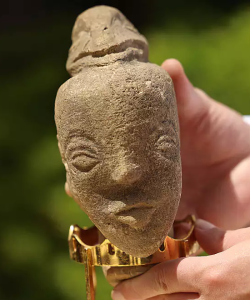 |
A•nãtꞋ;goddess of BaꞋal, probably derived from Sumerian InãnꞋnã (aka RæꞋa), worshiped from the 𒆠𒂗𒄀 (Kᵊnᵊgir) to ![]() (𐤌𐤑𐤓𐤉𐤌).
(𐤌𐤑𐤓𐤉𐤌).
A•nãtꞋ was also worshiped as the consort of a still-anthropomorphic יְהוָׂה by BCE 7th–5th century refugee-mercenaries from Yi•sᵊr•ã•eilꞋ,![]() rebel secessionists unwelcome in YᵊhūdꞋãh, who had fled the 𒀸𒋩𒆠 (Neo-Assyria) deracination of BCE 722 and settled in friendly
rebel secessionists unwelcome in YᵊhūdꞋãh, who had fled the 𒀸𒋩𒆠 (Neo-Assyria) deracination of BCE 722 and settled in friendly ![]() (𐤌𐤑𐤓𐤉𐤌) at Elephantine.
(𐤌𐤑𐤓𐤉𐤌) at Elephantine.![]() Unknowingly, some Jews today still name a daughter after this idol-
Unknowingly, some Jews today still name a daughter after this idol-goddess.
Note: Some scholars miss this and anachronistically assign after-the-fact, "Babylonian Exiles" from Yᵊrū•shã•laꞋyim, YᵊhūdꞋãh to Elephantine. This is patently untenable. While the later, BCE 6th century (BCE 586) Bã•vᵊl•imꞋ destroyed the Beit ha-Mi•qᵊdãshꞋ, they exiled only the top political and priestly leadership of YᵊhūdꞋãh, almost exclusively those living in Yᵊrū•shã•laꞋyim—which Elephantine Jews certainly were not! The Bã•vᵊl•imꞋ—only figuratively—"cut off the head" of their conquered adversary. This left most of YᵊhūdꞋãh—and "the Jews"—practically untouched, but leaderlessly dependent on, and subservient to, Bã•vëlꞋ (see the origins and development of Zūg•ōtꞋ). The Bã•vᵊl•imꞋ did not exile "the Jews". There was no Babylonian "Exile"; only a temporary exile of those of their leadership who had resided in Yᵊrū•shã•laꞋyim!

 |
ÃꞋnū•bis — Egyptian Animism & Anthropomorphism ![]() Due to the frequenting of wolves among the tombs, the wolf
Due to the frequenting of wolves among the tombs, the wolf![]() was believed to conduct the soul from the tomb to a set of judgment scales, where the heart was weighed on a scale against an ostrich feather.
was believed to conduct the soul from the tomb to a set of judgment scales, where the heart was weighed on a scale against an ostrich feather.
 |
In the middle panel, Finally, the priest who wears the falcon |
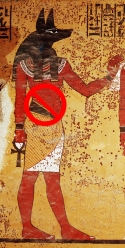 |
By the Middle Kingdom (c BCE 2100-1750), the role of Anubis mutated to Ö•sirꞋis.

 |
Hap ![]() — Egyptian Animism & Anthropomorphism
— Egyptian Animism & Anthropomorphism ![]() Hellenized (contrary to some sources) to Ἄπις mixed-gender
Hellenized (contrary to some sources) to Ἄπις mixed-gender god (fem. counterpart ᴷhãt-hōrꞋ).
Hap was regarded by ancient Egyptians as the creator of the universe; thought to "fetch water" of the annual flooding of the Nile. For ancient Egyptians, the arrival of the annual Nile inundation was the "Arrival of Hap".
 |  |
There is an Egyptian statue of "Hap" (Hellenized to ÃꞋpis) but the horns and top of the statue have been cut off. Therefore, I opted to illustrate with the painting demonstrating the passage of the "soul" of a Tzūran king (in Egypt, Par•ōhꞋ) from one designated bull (since bulls die and have to be replaced), awaiting to inhabit the next designated bull—misidentified as a sport of "bull-leaping".![]()

ÃꞋpëpGod Egyptian Animism & Anthropomorphism ![]() the encapsulation of all of the darkness, evil and chaos ("Eater of souls" and causer of natural disasters such as solar eclipse, floods, earthquakes and thunderstorms), epitomized in the Nile serpent-dragon
the encapsulation of all of the darkness, evil and chaos ("Eater of souls" and causer of natural disasters such as solar eclipse, floods, earthquakes and thunderstorms), epitomized in the Nile serpent-dragon god.
ÃꞋpëp seems unlike other ancient Egyptian gods in that some descriptions show similarities to crocodiles yët the "sacred crocodile" god was a distinctly different, nearly exact opposite of ÃꞋpëp: the ancient Egyptian god of order, power and fierceness: SōꞋbëq! In the Middle Kingdom (≈BCE 2055-1650), SōꞋbëq was frequently twinned as an ally with ᴷhãꞋrūs, and later with Rã.
Since most, perhaps all, other ancient animal gods were either real animals or chimera of real animals, perhaps a peculiar phenomena, occasionally experienced but never quite fully seen, may explain the ÃꞋpëp Nile dragon differently from a docile crocodile warming on the bank or lazily swimming. Unlike any other animal that I'm aware of, a gator or croc dismembers prey by death-rolling. This greatly roils the surrounding water, giving the impression of a much larger predator, of many coils; a much longer "Nile Dragon"—in a very chaotic, enormously powerful, ferocious, gruesome and deadly scene. What actually happens, however, is mostly underwater, surrounding roiling and splashing—some occasionally observed (thus real), but never fully seen (thus highly exaggerated), "Nile Dragon-Serpent"—ÃꞋpëp!
ÃꞋpëp parallels the Semitic Sã•tãnꞋ—sharing its origin with the serpent in the Garden of Eden.
 |
The ancient Egyptians' primary god was Rã, their sun god. When ancient Egyptians saw the sun proceeding through the sky, they believed it to be the radiance from Rã in his flat-bottom Solar-Nile ship ![]() (
(Rã-boat), being pushed along in its orbit around a flat earth by a dung-beetle (hence, the importance of the dung-beetle scarab).
By night, they imagined the sun proceeding in the return direction underneath their flat world, through what they believed to be the netherworld of demons. (Since they believed they had to make this trip at death to an eternal tomorrow, they—as well as Vikings and others—built solar barques to be buried with them.) In this mythical netherworld, they believed that mythical Rã was attacked each night by its mythical enemy—ÃꞋpëp. If ÃꞋpëp succeeded, then, they feared, the sun would not rise the next morning—the end of the world!
As a result, ancient Egyptians could never be sure even that the sun would come up the next morning (much less the next moon, the next season, Nile Flood, etc.). Consequently, ÃꞋpëp was their Chief Demon and threat to their primary god—and Par•ōhꞋ was believed to rule by divine-power,![]() having special influence with their
having special influence with their gods to further the welfare of his people. After all, the sun did come up every morning, the lunar months, the seasons, the annual Nile Flood, etc. (Quintessential example of post hoc ergo propter hoc logic fallacy.) Thus, they were dependent upon Par•ōhꞋ even for the next sunrise.
According to ancient Egyptian beliefs, the sun (Rã) Journeyed Across the sky in a "Heavenly-Nile" ship, pushed by a mythical dung (scarab) beetle. Each evening, the believed, Rã, in his "Heavenly-Nile" ship, descended below the horizon into the underworld (netherworld), where ÃꞋpëp ruled! Rã depended upon, Sët, using his snake-killing Wãss scepter, to kill the ÃꞋpëp serpent (see pic).
ÃꞋpëp was so demonized by fearful Egyptians that "Every year, a ritual called the "Banishing of ÃꞋpëp" would be held by the priests of Rã. They would take an effigy of ÃꞋpëp and in the center of the temple they would pray that all the wickedness in Egypt would go into the effigy. Then they would trample the effigy, crush it, beat it with sticks, pour mud on it, and eventually burn and destroy it. In this way, they believed (faith) the power of ÃꞋpëp would be curtailed for another year."![]() This idolatrous myth is the basis of today's annual Islamic practice of "the throwing of the jamarāt" (stoning of the Devil) during the Haj to Mecca.
This idolatrous myth is the basis of today's annual Islamic practice of "the throwing of the jamarāt" (stoning of the Devil) during the Haj to Mecca.

![]() ApolꞋlōn (Anglicized to A•polꞋlō)
ApolꞋlōn (Anglicized to A•polꞋlō)![]() Derived from the ᵏHa•tᵊtū´sha 𒀀𒀊𒉺𒇷𒌋𒈾𒀸 the ideal young, beardless, virile, manly-athletic man-
Derived from the ᵏHa•tᵊtū´sha 𒀀𒀊𒉺𒇷𒌋𒈾𒀸 the ideal young, beardless, virile, manly-athletic man-gōd, the son of man-gōd Ζεύς, the Hellenist (Greco-Roman) version of Egyptian Rã (Sun-)Gōd, the Son of (Greco-Roman) Gōd(along with ᴷhãꞋrūs & Gãd)—inspiration for the Eureka "epiphane" of the Excised-Apostate Hellenist Paul "on the road to Damascus"!
Apollo was the Greco-Roman god of, inter alia, sun & light, truth, prophecy, healing, knowledge, herds & flocks and villages (cities).

 natl deity britannica dot com 300x225.jpg) |
Assyrian Animism & Anthropomorphism ![]()
![]()
A•shūrꞋgod of fortune (symbolized by whether an arrow strikes or spares (win∕ validation) the archer's target) — also the name of the country (translated "Assyria," modern Syria) as well as the people (Assyrians-Syrians).
Adapted from Semitic (ᵏHa•tᵊtū´sha, Sumerian, et al.) 𒂗𒆤 En•ᵊlilꞋ; later El•ilꞋ & El / Æl (Eil).
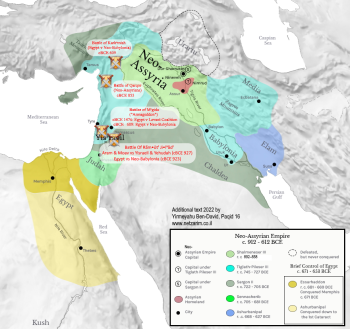 |
![]() אָשֵׁר (
אָשֵׁר (ÃꞋshær ![]() ; favored by
; favored by ÃꞋshær, the God of fortune and validation; fortunate, validated — name of Ya•a•qovꞋ's 8th son (mother: Zi•lᵊp•ãhꞋ, LeiꞋãh's maid).
אַשׁרֵי (a•sh•r•eiꞋ); may the fortunes and validations of A•shurꞋ, the fortune-God, be with (you, him, her, etc.); i.e., feel fortunate, validated, happy.
![]() אַשְׁרָה (a•shᵊr•ãhꞋ);
אַשְׁרָה (a•shᵊr•ãhꞋ); Astarte/Easter, date-palm grove dedicated to Astarte/Easter. Never before published evidence: ![]()

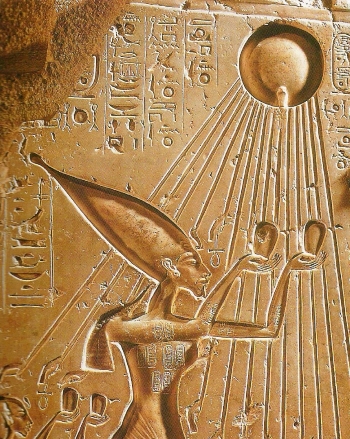 |
ÃꞋtën — Egyptian Animism & Anthropomorphism ![]() the solar disk, the manifestation of
the solar disk, the manifestation of Rã.
"In its early stages Atenism is best described as a henotheistic religion (a religion devoted to a single god while accepting the existence of other gods) but it developed into a proto-monotheistic system. The full extent of his religious reforms were not apparent until the ninth year of his reign. As well as proclaiming the AtꞋen the only god, he banned the use of idols with the exception of a rayed solar disc. He also made it clear that the image of the AtꞋen only represented the god, but that the god transcended creation and so could not be fully understood or represented. This aspect of his faith bears a notable resemblance to the religion of Moses, prompting Freud to suggest [anachronistically, since this was 1¾ centuries after Mosh•ëhꞋMosh•ëhꞋ!] that Akhen-AtꞋen was the first Monotheist. … The AtꞋen was worshiped in the open sunlight, rather than in dark temple enclosures, as the old gods had been."![]()
"But indeed, Akhen-AtꞋen's new creed could be summed up by the formula, 'There is no god but AtꞋen, and Akhen-AtꞋen is his prophet'."![]()

𒀭𒁕 𒃶 [Updated: 2024.02.07]![]()
 Sumerian antediluvian sage (apkallu) 150x420.jpg) |
Dã•gōnꞋMa•rᵊdūkhꞋ ![]() ) to Pūlossians to Romans & Christians (inherited in Roman Catholic Bishops' hats): Universal Human Animism & Anthropomorphism
) to Pūlossians to Romans & Christians (inherited in Roman Catholic Bishops' hats): Universal Human Animism & Anthropomorphism ![]() ; Hebrew דָּגֽוֹן = דָּג (dãg, fish) + suffix -ōn = Dã•gōnꞋ
; Hebrew דָּגֽוֹן = דָּג (dãg, fish) + suffix -ōn = Dã•gōnꞋ

Deus physicomorphic (anthropomorphic) idol ![]() [Updated: 2025.06.20]
[Updated: 2025.06.20]![]()
While Latin deus can be translated as and bears superficial similarity to Greek θεός theós, meaning 'god', these are false cognates. (Yet, Latin Deus consistently translates Greek Θεός Theós in both the Vetus Latina and Jerome's Vulgate. In the Septuagint, Greek Theós in turn renders Hebrew Elohim (אֱלוֹהִים, אלהים), as in Genesis 1:1: ) A true cognate of Deus is Ancient Greek Ζεύς, king of the Olympian gods in Greek mythology. https://en.wikipedia.org/wiki/Deus So, Deus ≡ Ζεύς which the Xn "Bible" migrates to "Gad/God"

גָּד physicomorphic (anthropomorphic) idol![]() [Updated: 2025.05.30]
[Updated: 2025.05.30]![]()
Gãd ≡Eil; Eil ≡God—A priori, Gãd ≡God! ![]()
This is not a mere pedanticism. Gãd, Eil in Hebrew, is often paired with the main God/Gãd/Eil/אֵל in many ancient regions. Yet, we find Gãd is (also) a distinct, "supreme" god. Thus, in Aram, for example, the regional "supreme" gãd was the ram-Gãd; but Gãd was paired with the "supreme" (huh?) god A•shūrꞋ, also spelled, inter alia, ÃꞋshær. Gãd was no mere attribute of A•shūrꞋ. "Thunder & Lightning"! Not the same as "Fortune"! Two distinct entities, paired.
This pair— Gãd & ÃꞋshūrÃꞋshær)—were supreme gods-pair in Haran, Paddan Aram—Lavan's 2 gods!
Gãd, son (and Tribe) of Yi•sᵊr•ã•æl´ and the idolatress handmaid, בִּלְהָה, of his favored wife, Rã•khælꞋ![]() .
.
, skygod Amun-Ra Zeus Jupiter 0350x422.jpg) |
Take a close look at the face! Grecian features, not even Semitic much less a Jew! Yet, it is the still-migrating, eventual face of the Hellenized pantheonic perception of |
The first usage of "God", to represent Greek θεός = Latin Deos or Deus≡θεός or Ζεύς (as both both Greek words equate to later Latin Jupiter, ergo each other.![]() Apriori,
Apriori, Ζεύς≡θεός≡Ζεύς≡Assyrian "Gãd/God & Greco-Roman Jupiter"!!!)
The first usage of English god in (Christian [Καινής Διαθήκης] translations, was in the Gothic translation of the [Καινής Διαθήκης] by Ulfilas. The earliest extant fragments of this "Wulfila Bible" consist of codices and one lead tablet—from the 5ᵗʰ century and not completed until the 8ᵗʰ century CE! That is so-o-o late! (How late is it?) It's so late that it's irrelevant by ≈½ a millennium! (The earliest extant codices are 4ᵗʰ century CE Greek—Sinaiticus & Vaticanus—containing the complete Καινής Διαθήκης, itself based on ooa plethora of papyri fragments.
Though both Jews and Roman Catholics have tried to bury a Ram-headed "God", the supposed distinction is nonexistent. It is an artificial distinction of the one original idea-word, as it migrated into different cultures & languages. Gãd is God; both ancient idols.
What, for different reasons, both were desperately trying to avoid was the elephant in the room: while Yo•seiphꞋ Bën-Ya•a•qōvꞋ and MiꞋrᵊyãm Bat-Æl•iꞋ ![]() were Tōr•ãhꞋ-abiding Yᵊhūd•imꞋ and parents of the Tōr•ãhꞋ-abiding mortal Riy״by, lᵊ-ha•vᵊdilꞋ, "
were Tōr•ãhꞋ-abiding Yᵊhūd•imꞋ and parents of the Tōr•ãhꞋ-abiding mortal Riy״by, lᵊ-ha•vᵊdilꞋ, "Mary, the supernaturally-impregnated Consort & Mother of (lost the Ram-horns) !Gãd
God Gãd, god and gãd), see also god; sky & lightning god of fate & destiny. Its associated sacred animal is the eagle (often holding a thunderbolt in its talons [now where have I seen that? 🤔]), its sacred tree is the oak; evolved from the ram-headed Egyptian Amun-Ra, later evolved into Hellenist Ζεύς (to Roman Jupiter [From Old Latin deiuos, from Proto-Italic *deiwos, from Proto-Indo-European *deywós. An o-stem derivative from *dyew- ("sky, heaven"), from which also diēs and Iuppiter. https://www.wordsense.eu/deus/#Latin]); also name of Ya•a•qovꞋ's 7th son (mother: Zi•lᵊp•ãhꞋ, LeiꞋãh's maid).
Hellenized to Γάδ, (Roman) Latinized to Gad (pronounced in Latin as the English "God")—while the Latin term for Γάδ was Deus. Anglicization then baselessly to both: Gad & God; same word prior to Anglicization. Gãd, son (and Tribe) of Yi•sᵊr•ã•æl´ & זִלְפָּה; whose 2 sons she named after the 2 tᵊrãph•imꞋ—Gãd & A•shūrꞋ—that she had stolen from her physicomorphic (animist) father לָבָן and secreted on her person.
The kᵊtiv of bᵊ-Reish•itꞋ 30.11, בגד, means "by God!," similar to the form לַגַּד (la•gadꞋ; for God) in Yᵊsha•yãhꞋu 65.11 (in contrast to the qᵊræ of bᵊ-Reish•itꞋ 30.11, בּׂא גָד (bō gãd; [sky-]god comes!).
The form גַּדִּי (Gad•iꞋ; "My God") is found in bᵊ-Mi•dᵊbarꞋ 13.10-11.
The cognate גְּדִי (gᵊdi; goat-kid) perhaps led to the association, with the adoption of some features (e.g., the ram's horns) of the Egyptian idol, ÃꞋmūn-Rã = Ammon, as in Ammonites = Amman, origin of the name of the capital of Jordan.
As the deity of the sky & lightning, גָּד ≡ I•yōvꞋ ≡ Jove ≡ (Anglicized to "Job") was regarded as the chief god. Later, גָּד evolved (Hellenized by the Greeks) to Ζεύς and Roman (Latinized directly from Jove to) Jupiter.
However, none are יְהוָׂה (Existant)! Read the Shᵊm•aꞋ more closely.
For heirs of Avᵊrã•hãmꞋ, Yi•tzᵊkhãqꞋ and Yi•sᵊr•ã•eilꞋ, יְהוָׂה, alone, has always been our Only "ël•ōh•imꞋ" (see the Shᵊm•aꞋ).

| 𐎅𐎄 |
 son of Dagon (Sumerian Ishkur) hammer & lightning) 085x200.png) |
HãꞋdᵊdū — ᵏHa•tᵊtū´sha-Ugarit Semitic Animism & Anthropomorphism ![]()
BaꞋal-worshiping 𐤀𐤓𐤌𐤉𐤀 (Aramean) idol-god of lightning & thunder, hammer-wielding (origin of Thor), divine son of Dãg•ōnꞋ; originally Sumerian Ish•kūrꞋ; later Hebrew הֲדַ֜ד (Ha•dadꞋ & BaꞋal).![]()
Ugarit belief held that BaꞋal (Ha•dᵊdūꞋ) was the son of Dãg•ōnꞋ.

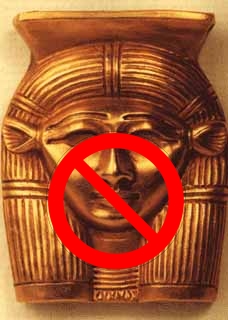 |
 Queen Nefertari To Osiris 226x350.jpg) |
Egyptian Animism & Anthropomorphism ![]() —
—Hãt-HōrꞋ, cow / heifer (origin of "holy cow") goddess of sex and fertility, wife (variously) of ᴷhãꞋrūs and Rã, welcoming the dead into eternal afterlife; depicted by the solar disk with WãdʸꞋet between the horns of a cow.
The face and head-dress of Hãt-HōrꞋ = IꞋsis was the pattern for the "Golden Calf" מַסֵּכָה.
Greek Hellenists syncretized Hãt-HōrꞋ to their goddess Aphrodite = Ash•tōrꞋët while Arabs syncretized it into Al•latꞋ and later Roman Hellenists syncretized it into Venus.
Hãt-HōrꞋ / IꞋsis / Ash•tōrꞋët is the original prototype of "Mary Mother of God."![]()

 |
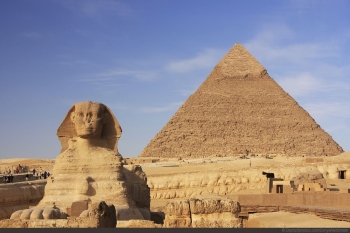 |
ᴷhãr-ëm-aᴷht ![]() — Hellenized, millennia later, and misleadingly called the Great “Sphinx” (a Greek cognate of “sphincter” meaning “strangler”) by Hellenists—not Egyptians—who believed a "strangler
— Hellenized, millennia later, and misleadingly called the Great “Sphinx” (a Greek cognate of “sphincter” meaning “strangler”) by Hellenists—not Egyptians—who believed a "strangler god" guarded the gate to the afterlife.
 ᴷhãt-shepset keruv sphinx (ancient-egypt co uk Metropolitan Museum) 250x376.jpg) |
Beyond a few cosmetic similarities to Greek statues of millennia later, the Greek-derived term sphinx (= strangler) has nothing to do with the much earlier ancient Egyptian statues. ᴷhōr-em-akht originally represented ᴷhãꞋrūs, god of the dawn, with the head of a ram (the guardian against the demons of the netherworld) on the body of a lion (the guardian of Rã).
 |
Two sculptures of Hōr-em-akht, back-to-back, guarding the comings and goings of Rã, symbolized, for Egyptians, the rule of the universe.
The Egyptian Hōr-em-akht statues bear a far closer resemblance to the kᵊruv•imꞋ (corrupted to “cherubim”) and sᵊrãph•imꞋ described by Yᵊkhë•zᵊq•eilꞋ (1 & 10) and Yᵊsha•yãhꞋu (6). See also, inter alia, Ancient Mysteries, Guardian of the Ages: The Great Sphinx, A&E Television Networks and The History Channel, 1996.

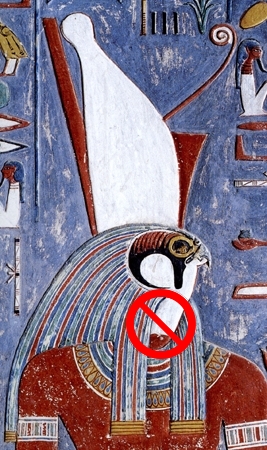 |
חֳרוּ(ס) — ᴷhãꞋrū(s), falcon; English "Horus".
Egyptian Animism & Anthropomorphism — ᴷhãꞋrūs ![]() ("falcon"), originally brother of
("falcon"), originally brother of Ö•sirꞋis, over time evolved to the son of IꞋsis and Ö•sirꞋis—"the Son of God"!
ᴷhãꞋrūs was the sky god of warriors, hunters and kings, depicted as a man with the head of a falcon wearing a combination of the red (Lower = north Egypt) and white (Upper = south Egypt) crowns; variously the son / husband of Hãt-HōrꞋ (often equated with IꞋsis).
12 year old Princess Par•ōhꞋ YakhꞋū-Mōses Mër•itꞋ-A•mūnꞋ, identifying herself with IꞋsis (incarnate), interpreted her discovering the infant Mosh•ëhꞋ floating among the reeds of the Nile as prophetic: that she had found ᴷhãꞋrūs, born, via herself (as IꞋsis-moses) and the recovered body parts of Ö•sirꞋis that had been scattered in the Nile. It is likely that the true mother of the Hebrew infant, Yō•khëvꞋëd, counted on the princess' belief in Egyptian idolatry to save him.
BCE 1ˢᵗ Century — Egyptian/Middle/Proto-Semitic 𐤇𐤓𐤐 𐤊𐤓𐤈 Thus, the Semitic derivation of both ancient Egyptian & Hebrew, again, correlate.
As 𐤇𐤓𐤐 𐤊𐤓𐤈 demonstrates by its partially-Hellenized, Semitic alphabet, Hellenization in BCE 1ˢᵗ century is already well underway—widely understood in Greek as the Geb-ᴷhãꞋrūs cross-over link, Ἁρποκράτης—precursor to Roman gods, and transitioning (thanks to the "epiphane", on the road to Damascus, Syria, of the Excised-Turkish Apostate Hellenist Paul's identity theft, to Romans' adaptation (and subsequent identity-theft) from the Excised-Apostate Hellenist Paul's First (7) Christian Church(es)—in Turkey (neither Rome nor Yᵊrū•shã•laꞋyim)!

Εἰδωλολατρία ![]() [Updated: 2022.12.12]
[Updated: 2022.12.12]![]()
Idolatry![]() Hellenist Greek LXX; has no corresponding single Hebrew source term in Ta•na״khꞋ.
Hellenist Greek LXX; has no corresponding single Hebrew source term in Ta•na״khꞋ. ![]()

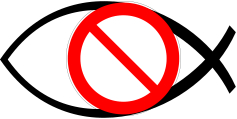 |
| Christian Ἰχθύς (fish) symbol |
ikh•thūs (Greek);gods; consequently adopting the sea god of their new land—the merman![]() fish-
fish-god theology that dated back to fish-centric NinꞋᵊweih theology similar at its core to their own sea-god theology.
 Sumerian antediluvian sage (apkallu) 150x420.jpg) |
This fish-god theology eventually evolved into the merman-god Triton (son of sea-god Poseidon), which thenceforth mutated into the Dãg•ōnꞋ fish-god theology of the Pᵊli•shᵊt•inꞋ, Aegean “Sea-People” colonists who took refuge in the coastal regions of the Eastern Medierranean, the Egyptian Delta and the Levant, in the wake of the destruction of their island capital by the Thæra eruption.
The original (i.e. followers of the Excised-Apostate Hellenist Paul, gentile Hellenist Turkish) Christians syncretized this fish-god tradition into the originally preferred of the two earliest Christian symbols—origin of the Roman Catholic Bishop's miter and form of the chess piece; the other, later, symbol being the cross.![]() These Greek-speaking gentile Roman Hellenist original Christians also developed an acronym for this symbol, in Greek (not in Hebrew, which gentile Roman Hellenists didn’t understand), for “
These Greek-speaking gentile Roman Hellenist original Christians also developed an acronym for this symbol, in Greek (not in Hebrew, which gentile Roman Hellenists didn’t understand), for “Iesous Khristos, Theou Uios, Soteir” (JC, god’s Son, Savior).

An — Sumerian & Akkadian Animism & Anthropomorphism ![]() (Sumerian; migrated to Akkadian ᵊlū) Sky-
(Sumerian; migrated to Akkadian ᵊlū) Sky-god, Sun-god; demigod probably based on legends idolizing ancestral rulers who identified with physicomorphic celestial lights (sun, moon, stars), fire, wind, "living (moving) water" & occasionally moving earth (quakes).
Monarchs (kings, Par•ōtꞋ, Shãhs, etc.), by virtue of their power (rule, reign & throne), were believed to be (have become) king-gods. At death they were believed to join the stars in the night sky, ruling over assigned aspects of nature. "Sons of the gods" were (as the Christian "son of god"), therefore, believed to become king-gods by right of Divine Succession.
Cognates include Ugaritic 𐎛𐎍 (ᵊil•ūꞋ), pl. 𐎛𐎍𐎚 ᵊilū•imꞋ; Aramaic (& Phoenician) 𐤀𐤋 (ᵊl), pl. 𐤀𐤋𐤌 (ᵊlim); Hebrew אֵל (Eil) & אֱלֹהַּ (Ë•lō•haꞋ), pl. אֵלים (Eil•imꞋ) & אֱלֹהִים (ël•ōh•imꞋ) and Arabic الله.
 Hittite cuneiform husband of Asherdu (Asherah) 325x87.jpg) |
الله Arab Animism & Anthropomorphism ![]() — Even after filtering out overwhelming flotsam of ill-informed anti-Islamist ranters, no one questions that the name
— Even after filtering out overwhelming flotsam of ill-informed anti-Islamist ranters, no one questions that the name Allãh clearly pre-dates Muhammad and Islam.
According to the Encyclopedia Britannica, Muslims sole, linchpin apology for Allãh is: "Etymologically, the name Allãh is probably a contraction of the Arabic al-Il•ãhꞋ, 'the God.' The name’s origin can be traced back to the earliest Semitic writings in which the word for 'god' was il or el, the latter being used in the Hebrew Bible…" [Technical note: in obedience to Shᵊm•ōtꞋ 23.13; Dᵊvãr•im´ 12.3; and Yᵊho•shuꞋa 23.7, idol names are deliberately distorted in Hebrew. "Eil" is a distorted form to avoid uttering the forbidden idol name (il).]
 130x200.jpg) |
| Corpse flower (Amorphophallus titanum) |
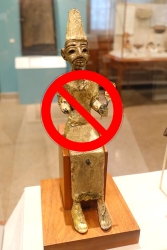 |
Calling a corpse flower an orchid doesn't make it an orchid; nor any less a corpse flower. Judged the most disgusting smelling flower in the world, a corpse flower, by any other name, would smell as foul.
Without the Hebrew Ta•n״kh´, Islam has no documented connection to Avᵊrã•hãm at all, nor any other basis whatsoever.
Yet, deriving Allãh from Hebrew and the Judaic Ta•n״kh´ is a double-edged sword. First, it acknowledges that the origin and Authority is Hebrew and Ta•n״kh´, not Arabic nor the Quran. Therefore, contradicting Ta•n״kh´ demonstrates prima facie idolatry.
Second, the Hebrew Ta•n״kh´ documents that Yi•sᵊr•ã•æl´ was repeatedly punished for dabbling in idolatry. Thus, Hebrew deific names used in Ta•n״kh´ cannot be simple-mindedly regurgitated carte blanche just because they are Hebrew or in Ta•n״kh´. Extrication from idolatry and idolatrous names demands nanoscopic scrutiny. Each form must be carefully understood.
 |
The Hebrew Ta•n״kh´ and Yi•sᵊr•ã•æl´ obliterated and entirely removed the forbidden idol-god name (perhaps something like אֳלֹה) from our lexicon, displacing it with the abbreviated אֵל. While rabbis today use the terms אֵל and אֱלֹהִים interchangeably as substitutes for יְהוָׂה, technically, they are not. As used in Ta•n״kh´, these words imply, respectively: (singular) "the forbidden-name idol regarded by the goy•imꞋ as god" and (plural) "the forbidden-name idol regarded by the goy•imꞋ as the gods." In place of all [regarded as] ël•ōh•imꞋ (including אֳלֹה / Allãh) [by the goy•imꞋ], the Shᵊm•aꞋ in our Hebrew Ta•n״kh´ teaches Yi•sᵊr•ã•æl´ that the only Prime Cause Singularity, encompassing all of the ël•ōh•imꞋ conceived by the goy•imꞋ, is יְהוָׂה.
By contrast, Muhammad, contradicting Ta•n״kh´, failed to completely eliminate idolatry from his Apostate Hellenist Paul-style, Displacement Theology of Islam, retaining the complete Arabic form of the forbidden idol-god: Allãh. The Hebrew Ta•n״kh´, specifically the Shᵊm•aꞋ, declares that יְהוָׂה, Alone as the Sole Singularity, has, for Yi•sᵊr•ã•æl´, displaced all of the idolatrous ël•ōh•imꞋ conceived by the goy•imꞋ lumped together—including אֳלֹה / الله (Al•lãhꞋ)!
Since there is no credible dispute among historians that pre-Islamic Al•lãhꞋ had a pre-Islamic consort—Al•lãtꞋ, the consort puts the lie to any and all denials that Al•lãhꞋ was a pre-Islamic idol!!!

 214x83.jpg) |
| |
Unless you've studied this website, you've very likely never been exposed to the discoveries that demonstrate that, 10,500 years (millennia) before Classic Greece), the Anatolian ᵏh•ūrꞋri, predecessors to their geographical neighbor and cousins, the ᵏHa•tᵊtū´sha were demonstrating advanced architectural technology unmatched for millennia, building great temples.
 150x240.png) |
They were engraving stone of this quality, and building temples that have stunned scientists (and pretty much shut up European and western arts-degreed adventurist "experts" ignorant of the Middle East/Asia)—like that of the ᵏHa•tᵊtū´shan Temple-Municipal building at Göbekli Tepe! European western adventurists ("archaeologists"), by arrogant choice, are still ignorant of the Middle East!![]() Unable to believe a people could be that ancient led them to make up a name for them rather than believe ancient sources; hence, during the Industrial Revolution of the 20ᵗʰ century, 1942 CE, the WWII generation: Presto! Minoans were invented—by an arts-degreed adventurist!
Unable to believe a people could be that ancient led them to make up a name for them rather than believe ancient sources; hence, during the Industrial Revolution of the 20ᵗʰ century, 1942 CE, the WWII generation: Presto! Minoans were invented—by an arts-degreed adventurist!
The little-known Semitic ![]() Anatolian
Anatolian ![]() ᵏh•ūrꞋri stretched from central Anatolia to Ninevah, Anatolia worshiped a
ᵏh•ūrꞋri stretched from central Anatolia to Ninevah, Anatolia worshiped a goddess of the spring revival of both plant and animal life—particularly hares & bunny rabbits due to their prolific fecundity—Shã•ūshꞋkã, whose male consort (likely her idol-brother, Tᵊshūb ![]() ), and full pantheon, are unknown to date.
), and full pantheon, are unknown to date.
Shã•ūshꞋkã was worshiped from ≈BCE 9—5 millennia, the dawn of human writing/history; the earliest goddess attested to date: 5000 years before the Sūmerians; 8,500 years before "Classical Greece, 11,000 Ya (years ago)—and the ultimate, direct-line origin of the Kᵊna•an•imꞋ goddess Ashtart (details below).
Judging from the dress of this idol, the original spring festivals of Shã•ūshꞋkã, at some later time, degenerated as the idol morphed through ensuing civilizations and cultures into unbridled public, hedonist carnal desire and erotic "lovin' & warrin'" that resulted in ancient Rome's Bacchanalia… and down to the present day as Christian-origin spring festivals of Mardi Gras, Carnival, Ishtar (Easter)—complete with the bunny symbol of sexual fertility & carnal pleasures and egg symbol of reproduction & fruitfulness.
Because spring was also the ideal season to invade the neighbors because of generally good weather, foraging & hunting—and (millennia before night vision goggles) spring culminated in the annual day in summer that "the sun stands still" "sol-stice" (Yep, exactly as noted by Yᵊhō•shūꞋa Bin-Nūn—except in Hebrew rather than Latin or Greek, of course; relying on KJ/V is so-o-o retarded)!
After Shã•ūshꞋkã, the Sū•mærꞋiy (Sumerians) worshiped I•nanꞋnã (≈BCE 4000-2400, male consort: Dū•mūzꞋiy).
 |
≈BCE 2400-0500 — A cross-cultural lineage of idolized legendary tribal-hero gods & goddesses, emanating from the primal mists of cave-fires lore of pre-history, threaded down in parallel through multiple tribes & civilizations. These commonalities are the underpinnings of every modern clergy. This is why every clergy fights historical, and much scientific, information. Consequently, expect raving flak in response to this logical-historical information.
While the names evolved and diverged by tribal ancestry, many of the main themes and characteristics echoed in each pantheon of idolized tribal-hero gods & goddesses throughout the Gondwana-ancestral (Semitic ᵏHa•tᵊtū´sha-Kᵊna•anꞋ land of a•dãm•ãhꞋ reflected the echos of their common, Gondwana-ancestral (Semitic) origin ![]() in cave superstitions.
in cave superstitions.
One of the earliest of these was Ish•tarꞋ,![]() morphed by the Tzūr•imꞋ to Ashtarte, transliterated into Ta•n״kh´ as עַשְׁתׁרֶת and Hellenized Ἀστάρτη, (Akkadian → Babylonian & Assyrian) male consort:
morphed by the Tzūr•imꞋ to Ashtarte, transliterated into Ta•n״kh´ as עַשְׁתׁרֶת and Hellenized Ἀστάρτη, (Akkadian → Babylonian & Assyrian) male consort: Tãm•mūzꞋ—the idol to which assimilated Babylonian Jews renamed the Hebrew 10ᵗʰ month!!!)
≈BCE 2400-0300, Hellenist Egyptian IꞋsis; male consort: Ō•siꞋrᵊs .
Pre-Hellenist Semitic (Gondwana-ancestry, not EurAsian/Greek) Kᵊna•an•imꞋ Ash•tōrꞋët (≈BCE 2400-), male consort: BaꞋal, followed by
Hellenist Greek Aphrodite (≈BCE 800-300) love, lust, passion, pleasure, beauty, and sexuality (in contrast to husband-god, Hephæstus), male consort: Ἄρης (the bull), followed by
The Roman pantheon split the earlier spring festivals into 3 Roman festivals; reapportioning the spring themes between:
Bacchus-Dionysus — Spring Bacchanalian Festival Themes: Although the purpose was presentation of plays, festivities began with the opening procession focused on carrying the idol of Dionysus into the city the parade included many escorts carrying giant penises along the procession route in honor to Dionysus (inherited from the Egyptian Ō•sirꞋis-ᴷhãꞋrūs Myth). Wine, liberality, getting drunk to remove inhibitions, revelry, sexual debauchery, orgies & ecstasy celebrated fertility and carnal lechery and revelry. The idol's Bacchanalia Spring Festivals were renowned for their wild celebrations, including feasting, drinking, breaking of societal inhibitions and ecstatic worship orgies—direct-line inspiration for Christian-era Roman Catholic Mardi Gras & Carnaval.
Flora — Floralia: Spring Renewal & Fertility Festival, Though Christian historians are loathe to mention them (because of the Easter connection to Ishtar / Astarte), hares, rabbits & eggs have always been associated with spring renewal. Themes: release of fertility symbols bunny rabits (hares) & goats; bearing sheaves of wheat to the temple; licentious, nude dancing including prostitutes, gladiator contests, theatrical performances, circus events; flowers and fertility
Venus — Veneralia: Spring Festival Themes: spring fertility, carnal love, lust & beauty.
In Turkey! (Not In Rome Nor Yᵊrū•shã•laꞋyim!)
Hellenist-Roman (Pantheon) Mary, mother, and female consort, of Hellenist-Roman (Pantheon) male consort: Hellenist "God", producing the Hellenist-Roman (Pantheon) Divine Son of the Hellenist-Roman (Pantheon) God—Divine-Zeus (Anglicized to
Jesus")!
Athtart was the primary inspiration molding the parallel lunar (i.e., moon, sex & fertility) goddesses of Arabia (Al•latꞋ, also known as al-ill•ahtꞋ, fem. of Al•lahꞋ). Hellenist Greece (Aphrodite) and Hellenist Rome (Venus)—making it also the origin, hatched by the latter (namely, Rome), of the Hellenist Christian Mardi Gras (French "Fat Tuesday" preceding Lent), South American Carnaval… and Easter—with Easter eggs derived from the birds' claws, tarsal spurs and wings of IshᵊtarꞋ (see pic—an egg-laying bird-woman)!
Due to their spectacular fecundity, hares (rabbits, bunnies) have always been associated with spring renewal of life. Hence, the (egg-laying) bird-featured IshᵊtarꞋ: the bunny (in the Playboy, sexual sense) with eggs! Christians deny it but facts remain in evidence: decoration of eggs dates back in Egypt and Sumeria 5,000 years (and almost certainly in Anatolia 5 millennia earlier and eons before writing and written history)!!! Priests, sorcerers, clergy—witch doctors all—merely copy traditions and adapt.
What does this have to do with Riy״by? Nothing whatsoever!!! It's blatant idolatry, the antithesis of Tōr•ãhꞋ & Riy״by!
Sadly, the בֵּיצָה on the PësꞋakh SeiꞋdër plate doesn't date back beyond the Gãl•utꞋ of 135 CE and resulting assimilation—adopting the "Easter egg" by giving it a "Jewish" theme—like an "Xmas bush"!
In Egyptian idolatry, Athtart was
equated to a daughter of Rã and IꞋsis, later Hellenized to Greek Astarte-Ashtoret idolatry that is so frequently reviled by the Bible — converged with Aphrodite (Budin, Stephanie L. (2004). "A Reconsideration of the Aphrodite-Ashtart Syncretism". Numen 51 (2): 95–145.), — becoming a Sã•tãnꞋ prototype.
Ash•tōrꞋët / Hãt-HōrꞋ / IꞋsis is the original prototype of "Mary Mother of God" ![]()

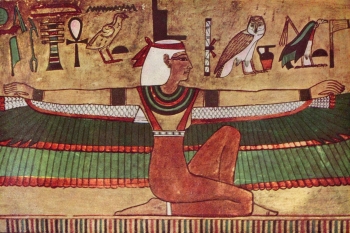 |
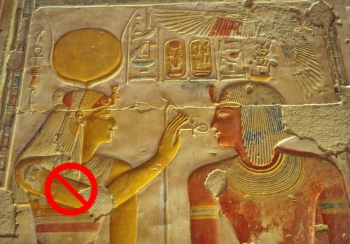 |
Egyptian Animism & Anthropomorphism — IꞋsis ![]() ("throne") was depicted by Egyptians as a woman wearing a falcon or throne head-dress and eventually equated with
("throne") was depicted by Egyptians as a woman wearing a falcon or throne head-dress and eventually equated with Hãt-HōrꞋ.
In keeping with the Egyptian tradition of Pharaohs keeping their "royal blood" in the family (incestuously), Mother IꞋsis married her brother-god, Ö•sirꞋis.
Mother IꞋsis conceived by Father Ö•sirꞋis god, giving birth to "the Son of God," ᴷhãꞋrūs, who was resurrected by Mother IꞋsis after being murdered by Sët (which later symbolized Rome, prefiguring Hellenist Roman Christianity).
“IꞋsis![]() Loop”
Loop”![]()
![]()
![]() (Egyptian
(Egyptian ![]() ). See also
). See also RëꞋa
The 12 year old princess of Shᵊm•ōtꞋ 2, identifying herself with IꞋsis (incarnate), interpreted her discovering the infant Mosh•ëhꞋ floating among the reeds of the Nile as prophetic: that she had found ᴷhãꞋrūs, born, via herself (as IꞋsis-moses) and the recovered body parts of Ö•sirꞋis that had been scattered in the Nile. It is likely that the true mother of the Hebrew infant, Yō•khëvꞋëd, counted on the princess' belief in Egyptian idolatry to save him.
 |
IꞋsis / Hãt-HōrꞋ / Ash•tōrꞋët is the earliest known prototype of "Mary Mother of god" ![]()

 |
כְּאָפִּי![]() ) African/Semitic languages.
) African/Semitic languages.
This sacred bull certainly tracks back from Par•ōhꞋ to ᵏHa•tᵊtū´sha and NëꞋsha. Notice the countless instances in which Egyptian-Africa/A•dãm•ãhꞋ/NëꞋsha-ᵏHa•tᵊtū´sha are all sister-languages deriving originally from Gondwanan-ancestry, not EurAsian-ancestry peoples. Likewise, the genetics of Gondwanan-ancestry peoples are all related to one another—in contrast to EurAsian peoples; and generally followed the geophysical bi-continental suture line.![]()
In the Hellenist-era of Ptolemy Sr. over Hellenized qqq Αἰγύπτος ![]() Αἰγύπτος "Egypt"—(BCE 369/68–282.01), Ptolemy coupled (
Αἰγύπτος "Egypt"—(BCE 369/68–282.01), Ptolemy coupled (Ō•sirꞋis) with (KᵊãꞋpi), displacing both with their contraction: Serapis, displacing the 2 with the Hellenized combination ():
The σεραπεῖον, the temple of Σάραπις/Σέραπις SaꞋra•pis/SëꞋra•pis), of MH: ꜣbḏw U23, D58 b, N26,O49 [https://ancientegypt.fandom.com/wiki/Abydos] ![]() (later Saqqara) was the ancient Egyptian burial place for sacred bulls of the Hap cult at ankʰ-TãꞋwi. It was believed that the bulls were incarnations of the
(later Saqqara) was the ancient Egyptian burial place for sacred bulls of the Hap cult at ankʰ-TãꞋwi. It was believed that the bulls were incarnations of the god Ptah, which would become immortal after death as Ō•sirꞋis-Hap, a name which evolved to Serapis (Σέραπις) in the Hellenistic period,

| |
| a•mãrꞋūt•ū ( |
 |
𒀭𒀫𒌓 (Ma•rᵊdukhꞋ)Bæl, conventionally "Bel", (paralleled Semitic-Hebrew BaꞋal); Hebrew
מַרְדוּךְ (Ma•rᵊdukhꞋ); also aka Enlil ![]() )— "solar bull calf"—paralleling the Kit•imꞋ bull;
)— "solar bull calf"—paralleling the Kit•imꞋ bull;![]() later, after the LBAC
later, after the LBAC ![]() , the Greek Ταῦρος. The Babylonian/
, the Greek Ταῦρος. The Babylonian/Creator and Lord of the Gods of Heaven and Earth", whose "star" was Jupiter![]() (lᵊ-ha•vᵊdilꞋ in Hebrew, TzëdꞋëq, planet of the Mã•shiꞋakh).
(lᵊ-ha•vᵊdilꞋ in Hebrew, TzëdꞋëq, planet of the Mã•shiꞋakh).![]()
The practice of the 7th-10th century CE Masoretes, who first codified modern Hebrew vowels, likely reflects early tradition to deliberately garble the names of foreign idols so as avert inadvertant contravention of Tōr•ãhꞋ forbidding vocalization of idol names (the original intent of Tōr•ãhꞋ being to forbid "calling on" them as foreign ël•ōh•imꞋ). Thus, we find Ma•rᵊdūkhꞋ garbled in Yi•rᵊmᵊyãhꞋū 50.2 & 52.31 as Mᵊrō•dãkhꞋ.
Ma•rᵊdūkhꞋ is also the base of the name "Mordecai" of PūrꞋim—which similarly lionizes Ës•teirꞋ (origin of Easter)! These are confirmation of the extent of BCE 6th century Babylonian assimilation.
The conjunction of the planets Jupiter & Saturn, presumably linked in some way to the constellation 𒀭𒀫𒌓 (Taurus), was predicted by Dãn•iy•ælꞋ in his "70 Weeks" during his time exiled in the Akh•sa•kh•ëmꞋ ![]() Persian Empire, when Shãh Kū•ū•rū•shã issued the edict to rebuild Yᵊrū•shã•laꞋyim—which is how the Persian Magi knew where and when to look for the Mã•shiꞋakh of the Yᵊhūd•imꞋ. See NHM
Persian Empire, when Shãh Kū•ū•rū•shã issued the edict to rebuild Yᵊrū•shã•laꞋyim—which is how the Persian Magi knew where and when to look for the Mã•shiꞋakh of the Yᵊhūd•imꞋ. See NHM ![]()

 |
Min was an Egyptian god of fertility and sexuality. Wall reliefs depict Min as a dark-skinned human, standing with its feet close together while holding a flail in its upraised right hand above its head and holding its erect penis in its left hand. Its headpiece is usually the two plumes of Amun , and it has two streamers hanging down the back its neck. In the pictured wall relief, it stands in front of a garden of long-leaved, Lactuca sativa, var. longifolia (Romaine) lettuce, a variety also grown in Israel in ancient times.![]()
 0350x526.jpg) |
“For nearly 3,000 years lettuce was associated with the Egyptian
godof fertility,Min, for its resemblance to the phallus“Lettuce has been harvested for millenia—it was depicted by ancient Egyptians on the walls of tombs dating back to at least [BCE 2,700]. The earliest version of the greens resembled two modern lettuces: romaine, from the French word “romaine” (from Rome), [derived from the Aramaic/
Hebrew חַסָּא, mistakenly] believed to have been found on the island of Kos, located along the coast of modern day Turkey.”
“[
Min] was associated with the Egyptian long-leaf lettuce… which was considered to be an aphrodisiac, as it is shaped like a phallus and secretes a milky substance which was likened to semen.”Minwas often shown standing before offering tables piled with heads of lettuce.
 |
“But in Ancient Egypt around [BCE 2,000], lettuce was not a popular appetizer, it was an aphrodisiac, a phallic symbol that represented the celebrated food of the Egyptian god of fertility,
Min. (It is unclear whether the lettuce’s development in Egypt predates its appearance on the island of Kos.) The god, often pictured with an erect penis in wall paintings and reliefs was also known as the “great of love” as he is called in a text from Edfu Temple. The plant was believed to help the god “perform the sexual act untiringly.”“Salima Ikram, Professor of Egyptology at the American University in Cairo who specializes in Ancient Egyptian food explains
Min’s part in lettuce history…“But in Ancient Egypt around[BCE 2,000], lettuce was not a popular appetizer, it was an aphrodisiac, a phallic symbol that represented the celebrated food of the Egyptian god of fertility,
Min. (It is unclear whether the lettuce’s development in Egypt predates its appearance on the island of Kos.) The god, often pictured with an erect penis in wall paintings and reliefs was also known as the “great of love” as he is called in a text from Edfu Temple. The plant was believed to help the god “perform the sexual act untiringly.…“The first of these depictions appeared around [BCE 1970-80] in the The White Chapel of Senusret I…
“One of the reasons why [Egyptians] associated the lettuce with
Minwas because it grows straight and tall—an obvious phallic symbol,” Ikram says. “But if you broke off a leaf it oozed a sort of white-ish, milky substance—basically it looked like semen.”
Interestingly, Hebrew מִין seems to be borrowed from the Egyptian god name!

Mithra;Rã), contracts, and friendship; a judicial figure, all-seeing protector of Truth, and guardian of cattle, harvest, and the waters.

NãꞋbū, (divinity prefix Nᵊvū-□, popularly Nebo or Nebū-□);![]() the Babylonian
the Babylonian god of literacy worshiped by Babylonians as the Supreme God Ma•rᵊdūkhꞋ. Semitic Hebrew Nã•viꞋ very likely branched off from the same origins and meanings as this Semitic Akkadian-Sumerian.

𒀭𒋀𒆠 ![]() (NãnꞋnã
(NãnꞋnã ![]() ) ≡ 𒀭𒂗𒍪
) ≡ 𒀭𒂗𒍪 ![]() (Sin
(Sin ![]() ) [Updated: 2025.05.17]
) [Updated: 2025.05.17]![]()
 limestone stela Tell Ahmar Syria BCE8th Aleppo Getty 350x280.png) |
NãnꞋnã / Sin![]() Sumerian
Sumerian NãnꞋnã, Semitic-Akkadian Sin were the respective moon-god Son of God; centers of worship located in Ūr & Khã•rãnꞋ—both residences of Avᵊrã•hãmꞋ.
Mesopotamian counterpart of Egyptian Hãt-HōrꞋ… to the Gold-Calf mask—in the סִינַי (Hebrew Sin•aiꞋ. Interestingly, the Semitic (Hebrew) ending, □י (□aiꞋ or □ãiꞋ) is the singular possessive suffix for a plural masc. noun—"my …s"), e.g. A•dōn•ãiꞋ translates to "my Lords! So Sinai has always meant, in all Semitic languages, "my moon-gods, plural—from the time of the original ᵏHa•tᵊtū´sha, 12,000 years ago! (But fundamentalist Christian Albright ![]() remained convinced that, when the Medieval King of England approved his English KJ/V that made it the "Word of
remained convinced that, when the Medieval King of England approved his English KJ/V that made it the "Word of God! After all, King James backed-up his new KJ/V English (of the Excised-Apostate Hellenist Paul's) Romanized churches, a few years AFTER his KJ/V, by back-translating his English version into a new Greek Textus Receptus! A miracle how Textus Receptus supports KJ/V!!!🙄

NëkhꞋbët (mother) — vulture goddess of motherhood & childbirth, associated with the color white; counterpert of WãdꞋjet.
 |
NëkhꞋbët became identified as the ultimate mother: i.e. Hãt-HōrꞋ— of later "Golden Calf" infamy.
Thus, this egg-laying white vulture mother-goddess morphed to twin the theme of an egg-laying white vulture-mother with the theme of mammal mother/Hãt-HōrꞋ—likely the ultimate origin of the "Easter Egg". (The "Easter Bunny" wasn't dreamed up until 17th century CE German Lutherans.)

 |
NëvꞋtiDemi-goddesses" (unifying "2 Lands"):
[a] Upper (South, 𓇓 (Shã•mūꞋ, sedge, M23) @ 𓋆, scepter w/feather R19 ŪãsꞋët, 𓏏 X1 t, וּאַסֶט); 𓊖 O49 niōt/city (of the scepter, now Luxor / Thebes Temple area: Karnak & Valley of the Kings) — NëᵏhꞋbët; name of mūt/mother-goddess (vulture, G14 @ WASETqqq) &
[b] Lower (North, Delta) — WãdꞋyet (wꜣḏt; green: symbol of life, revival, fertility), winged (???) I•yarꞋët (erect cobra, later Hellenized to Ουραῖος (Oū•rīꞋ•ōss [aū as in author; rī as in rye or eye; ōss as in Betsy Ross]); name of goddess of ![]() (M17 i, Aa15 hlovrlp im, G17 m, X1 t, A17 child xrd, O49 niwt; Imet). When depicted with
(M17 i, Aa15 hlovrlp im, G17 m, X1 t, A17 child xrd, O49 niwt; Imet). When depicted with Rã (the sun disk), the Eye of Rã), . When depicted with the , erect cobra on a basket (I12, jꜥrt, eeYARet) עִיַרֶת; name of WãdꞋyet);
— i.e. the Par•ōhꞋ who reunified Mi•tzᵊr•ayꞋim.![]() N35 water-ripple, n; Aa1 Placenta or sieve ח ᵏh; D58 foot b; M22 marsh rush n/צ.
N35 water-ripple, n; Aa1 Placenta or sieve ח ᵏh; D58 foot b; M22 marsh rush n/צ.![]()

 |
Egyptian Animism & Anthropomorphism— Ō•sirꞋis ![]() symbolized resurrection; depicted as a green-skinned man (the color of resurrected crop greenery following the annual flooding of the Nile) or black (color of the fertile Delta soil), a beard symbolizing eternity (the "pharaoh's beard") and partially mummy-wrapped at the legs, epitomizing the transition from death to eternal afterlife.
symbolized resurrection; depicted as a green-skinned man (the color of resurrected crop greenery following the annual flooding of the Nile) or black (color of the fertile Delta soil), a beard symbolizing eternity (the "pharaoh's beard") and partially mummy-wrapped at the legs, epitomizing the transition from death to eternal afterlife.
Ō•sirꞋis is also the origin epitomizing divine right to rule (still claimed today by every king and queen), holding the crook and flail; and rule over combined Upper (southern) and Lower (northern and Delta) Egypt, often wearing a distinctive crown with two large ostrich feathers (symbolizing Upper & Lower Egypt) at either side.
Ō•sirꞋis was the Father-God (by IꞋsis, the Mother-goddess) of ᴷhãꞋrūs: the "Son of God"! This is the ultimate origin later syncretized by Hellenist Roman idolaters of the 2nd-4th centuries CE into the concept of the Father-God, "Mother of God" and "the Son of God."
Like Rã (the sun) was thought to spend each night in the underworld and resurrect each morning, his son, Ō•sirꞋis, was regarded as a merciful god of the dead, God over transition from death to resurrection and afterlife. In the 2nd-4th centuries CE, Hellenist Roman idolaters syncretized this Ō•sirꞋis (& IꞋsis-ᴷhãꞋrūs">ᴷhãꞋrūs) Myth into a divine Jesus' supposed power over sin, death and resurrection.
The myth mostly evolved ≈BCE 2686-2181, with Ō•sirꞋis, the gōd of fertility, agriculture, the afterlife, the dead, resurrection, life, and vegetation in ancient Egyptian religion ruling Egypt, having inherited the kingship from his divine ancestors in a lineage stretching back to the creator of the world: Rã or ÕtūmꞋ.
Ō•sirꞋis was classically depicted as a green-skinned deity with a pharaoh's beard, partially mummy-wrapped at the legs, wearing a distinctive ãꞋtëph crown and holding a symbolic crook and flail. He was one of the first to be associated with the mummy wrap.
His queen was IꞋsis, who was one of the main characters of the Ō•sirꞋis myth, in which she resurrects her murdered brother-husband, the divine king Ō•sirꞋis, and she produces and protects his heir, ᴷhãꞋrūs.
IꞋsis, who, along with Ō•sirꞋis, and his brother, Sët, is one of the children of the earth gōd Gëb and the sky goddess Nūt. … Ō•sirꞋis is connected with life-giving power, righteous kingship, and the rule of maꞋat, the ideal natural order whose maintenance was a fundamental goal in ancient Egyptian culture.
Sët murders his brother Ō•sirꞋis. Ring a bell? (Like QaꞋyin & HëvꞋël?) The myth illustrates the ever-present struggle to retain, or displace, power. Sët is closely associated with the violent taking of power. (It is ÃꞋpëp, however, most associated with chaos, evil and death.) Accordingly, the mythical fratricide of Ō•sirꞋis symbolizes the never-ending struggle between those in (claimed "Divine Right") power and those determined to forcibly displace them.
By the end of the New Kingdom, a tradition had developed that Sët had cut Ō•sirꞋis's body into pieces—except his penis, which he threw into the Nile where it was eaten and destroyed by a catfish—and scattered them, a part in each of the 42 nomes, thus encompassing, and embodying, greater Egypt. …
After Ō•sirꞋis' brother, Sët, had cut Ō•sirꞋis into pieces after killing him, his sister-wife, IꞋsis, with her sister NëphꞋthys, searched Egypt to find each part of Ō•sirꞋis. She collected all but one body part—Ō•sirꞋis’ penis. She then pieced him back together and wrapped his body up like a mummy; returning him to life. (Note: different ancient versions of this myth varied, ascribing different gods to different roles.)
Contrary to much later Greek recounts of this myth, in some early Egyptian versions it is the goddesses who find, restore and mummify Ō•sirꞋis' body (origin of mummification) including, magically, his restored penis—which had been cast into the Nile and eaten by a catfish. ![]() In most early Egyptian versions, however, it seems to be
In most early Egyptian versions, however, it seems to be IꞋsis who does all of this.
![Cartouche from outer coffin, Princess/Queen [Yãh-Mose] MᵊRiyt Amūn Cartouche from outer coffin, Princess/Queen [Yãh-Mose] MᵊRiyt Amūn](../Temunot/Princess Merit[Amun cartouche 0350x190.png) |
In some Egyptian accounts of Ō•sirꞋis (& IꞋsis & ᴷhãꞋrūs) Myth, IꞋsis impregnates herself on the magically-restored penis of resurrected Ō•sirꞋis, and the pregnant IꞋsis hides from Sët, to whom the unborn child is a threat. IꞋsis then gives birth to ᴷhãꞋrūs in a thicket of papyrus in the Nile Delta..
qqqThis is the point where Yō•khëvꞋëd, MiꞋrᵊyãm & Pharaonic Princess (later Queen) xYahMosesL3 MᵊRiyt Amūn
& Sët (who turns out to be homosexual) contend for the throne. IꞋsis intervenes on behalf of Ō•sirꞋis (& IꞋsis-ᴷhãꞋrūs) Myth but accidentally harpoons him. Ō•sirꞋis (& IꞋsis-ᴷhãꞋrūs) Myth struck out blindly at his perceived attacker, accidentally beheading his mother, IꞋsis.
IꞋsis resurrects ᴷhãꞋrūs, the "Son of Gōd", who then battles Sët to rule over Egypt. IꞋsis attempts to help ᴷhãꞋrūs, missing & hitting ᴷhãꞋrūs, who reflexively strikes out at his perceived attacker, beheading his mother. Tūt replaces the head of IꞋsis with the head of a cow: Hãt-HōrꞋ. (In another tradition, Hãt-HōrꞋ is regarded as his mother and sometimes as his wife.)
The most commonly encountered mythical family relationship describes Ō•sirꞋis (& IꞋsis-ᴷhãꞋrūs) as the son of IꞋsis and Ō•sirꞋis, and he plays a key role in the Ō•sirꞋis myth as the mythical Egyptian God, the Son of God—sound familiar? The names were changed when the Greeks eclipsed Egypt; names changed again when Romans supplanted the Greeks; names changed again when the Apostate Hellenist Paul recast the myth in "Jewish" terms.
The Ō•sirꞋis (& IꞋsis-ᴷhãꞋrūs) myth, famliar to all Yi•sᵊr•ã•æl´ sojourning in Mi•tzᵊr•ayꞋim, including xYokhabedL3
was told by his mother, IꞋsis, to protect the people of Egypt from Sët, the gōd of the desert, who had killed Ō•sirꞋis (& IꞋsis-ᴷhãꞋrūs) Myth' father, Ō•sirꞋis. Ō•sirꞋis (& IꞋsis-ᴷhãꞋrūs) Myth had many battles with Sët, not only to avenge his father but to choose the rightful ruler of Egypt. In these battles, Ō•sirꞋis (& IꞋsis-ᴷhãꞋrūs) Myth came to be associated with Lower Egypt and became its patron. … The Eye of Ō•sirꞋis (& IꞋsis-ᴷhãꞋrūs) Myth … Wedjat (Wadyet)

 |
Egyptian Animism & Anthropomorphism — creator god,![]() depicted as a man wearing a skullcap who conceived the world and spoke it into existence; also the
depicted as a man wearing a skullcap who conceived the world and spoke it into existence; also the god of craftsmen and architects. Ptah became identified with Ö•sirꞋis.

 |
 and Imentet tomb of Nefertari BCE 13th 0350x421.jpg) |
Egyptian Animism & Anthropomorphism — Rã, ![]() the self-created creator and sun-
the self-created creator and sun-god, believed to cruise the sky during the day in its Solar Boat and through the netherworld during the night, culminating in a confrontation with the evil ÃꞋpëp serpent god that had to be defeated every night.
Every night, Rã delegated the battle with the evil ÃꞋpëp serpent to the violent-disorder-foreigner god Sët, depending upon Sët's victory for Rã to be "born-again" every morning. (This is the original derivation, syncretized by the Hellenist Roman idolaters of the 2nd-4th century CE, into Jesus' victory over death enabling Christians to be "born-again.")

 |
RëꞋaRëꞋa (also Rhea);![]()
![]()
![]() Chief Deity of the Aegean-Mediterranean “Sea People” Thalassocracy;
Chief Deity of the Aegean-Mediterranean “Sea People” Thalassocracy;![]() believed to be the Mother-
believed to be the Mother-Goddess![]() of the world—thus conflating, via both maritime and land trade merchants, with Egyptian
of the world—thus conflating, via both maritime and land trade merchants, with Egyptian IꞋsis, moon-goddess Hãt-HōrꞋ,![]() Sumerian
Sumerian Inanna/Ish•tarꞋ/Astarte /Asherah/Easter, Greek Aphrodite and Mary goddess, Consort of \<www.jstor.org/stable/3136671\>.','#dfefff', 260)"; onMouseout="hideddrivetip()">God & Mother of God![]() as well as
as well as Oannes/Enki/Dag•ōnꞋ.![]()
RëꞋa’s identification with the sea and mythical merman gods is immediate: RëꞋa was believed to be the daughter of Oceanus (divine personification of the ocean) and Tæthus![]() , mother of the river
, mother of the river gods and the mermaids (sea nymph deities). The (Hellenic Mycenean) Kᴴa•tᵊ•tūꞋshan-Pūlossians likewise believed that RëꞋa was the mother of Poseidon, who, with his consort, Amphitrite, gave birth (among other gods) to a merman sea-god, Triton![]() —“always conceived as presenting the human figure in the upper part of their bodies, while the lower part is that of a fish”
—“always conceived as presenting the human figure in the upper part of their bodies, while the lower part is that of a fish”![]() ) as well as
) as well as Ζεύς.![]() “
“Amphitrite, [conflated with both RëꞋa and Greek] Athena, is the paredros![]() of the deity who was worshiped by the [Pūlossians] as Dãg•ōnꞋ, [which] in Greek lands became
of the deity who was worshiped by the [Pūlossians] as Dãg•ōnꞋ, [which] in Greek lands became Triton, Apollo Delphinius, Poseidon [and] Ζεύς.”![]()
Fish accompanied the Kᴴa•tᵊ•tūꞋshan motifs on pottery, wall paintings, etc. The whole gamut of Kᴴa•tᵊ•tūꞋshan figurines (idols), however, have been largely exposed as forgeries.![]() Imagery, consequently, is limited to wall frescos excavated by archeologists with provenance to Knossos, Palaikastro (Crete) or Akrotiri (Kal•lisꞋtæ).
Imagery, consequently, is limited to wall frescos excavated by archeologists with provenance to Knossos, Palaikastro (Crete) or Akrotiri (Kal•lisꞋtæ).
RëꞋa is depicted wearing the “IꞋsis![]() Loop”
Loop”![]()
![]()
![]() (Egyptian
(Egyptian ![]() , “Sacred Knot”) bow on her back, which is likely an abbreviated abstraction (like the
, “Sacred Knot”) bow on her back, which is likely an abbreviated abstraction (like the ikhꞋthūs) of their maritime fish priestly garb![]()
![]() (inspiring angelic wings and “Wonder Woman” with her magic lasso in foreign cultures). The “
(inspiring angelic wings and “Wonder Woman” with her magic lasso in foreign cultures). The “IꞋsis![]() Loop” identifies this not as a mere priestess; in the Kᴴa•tᵊ•tūꞋshan religion, this (perhaps a living queen) was the their principle
Loop” identifies this not as a mere priestess; in the Kᴴa•tᵊ•tūꞋshan religion, this (perhaps a living queen) was the their principle goddess “incarnate”: RëꞋa.

 130x177.jpg) |
wearing a modius crown (B.C.E. 4th century) "Missing link" between Egyptian mythology and Hellenist mythology (which morphed into Christian Face of Christ) |
Ō•sirꞋis + !Awp to Ser-apis Syncretization of by Greek Alexandrian-General Ptolemy Sr., Soter [Σωτήρ (Sōtḗr), meaning a saviour, a deliverer… A title of gods: Poseidon Soter, Zeus Soter, Dionysus Soter, Apollo Soter, Hades Soter, Helios Soter; wiki/Soter] in order to facilitate unification by Hellenizing Egyptians into the Greek pantheon.
Although the connection of Helios to Zeus does not seem to have basis in early Greek cult and writings, nevertheless there are many examples of direct identification in later times.[312] The Hellenistic period gave birth to Serapis, a Greco-Egyptian deity conceived as a chthonic avatar of Zeus, whose solar nature is indicated by the sun crown and rays the Greeks depicted him with.[313] Frequent joint dedications to "Zeus-Serapis-Helios" have been found all over the Mediterranean, for example, the Anastasy papyrus (now housed in the British Museum equates Helios to not just Zeus and Serapis but also Mithras,[314] and a series of inscriptions from Trachonitis give evidence of the cult of "Zeus the Unconquered Sun" (wiki/Zeus)
Serapis Alexander Hellenized physicomorphic mythical animal Hap to the Greek physicomorphic mythical ÃꞋpis, the bull-idol, which he also anthropomorphized with Ō•sirꞋis into a human-like idol: Σέραπις "../../"Museum/Sukkah09/Sukkah09new.htm"
Serapis was extensively popularized in the third century BC on the orders of Greek Pharaoh Ptolemy I Soter,![]() as a means to unify the Greek and Egyptian subjects of the Ptolemaic Kingdom.
as a means to unify the Greek and Egyptian subjects of the Ptolemaic Kingdom.

Egyptian Animism & Anthropomorphism ![]() — wolf
— wolf![]() mask, worn by an Egyptian priest;
mask, worn by an Egyptian priest; god of the desert, storms, disorder, violence and foreigners.
 and Osiris (r) blessing Ra-moses Jr temple at Abu Simbel 0350x376.jpg) |
Younger son of Rã, Sët was the brother of Ö•sirꞋis.
While it was Sët who dispatched the evil ÃꞋpëp serpent every night, enabling Rã to be reborn every morning, it was also Sët who murdered his older brother, Ö•sirꞋis, in order to take the throne.
To prevent Ö•sirꞋis from resurrecting himself like (Egyptians believed) their father, Rã, did every morning, Sët butchered Ö•sirꞋis and scattered his body parts throughout the Nile.
The mask-portrayal of the mythical-god of Sët is not known—until right now as I publish it (2025.05.18).![]() Contrary to (Ph.D.) and myriads of other speculators, popular interpretations, his wãs scepter is totally not-understood, at all, and misrepresented. The beauty is, when it's right, many "stray" pieces, equally not-understood, fall into place to form a perfect picture.
Contrary to (Ph.D.) and myriads of other speculators, popular interpretations, his wãs scepter is totally not-understood, at all, and misrepresented. The beauty is, when it's right, many "stray" pieces, equally not-understood, fall into place to form a perfect picture.
Sët was associated with, and the power of his scepter—of the mythical Atum (the mythical Egyptian self-created creator of all)—is credited for his victorious (mythical) battle, from the bow of conquering the mythical Typhonian/Typhonic serpent, aka ÃꞋpëp (Hellenized to Apophis, their serpent-god that devoured Ra/sun every evening—and a "BënꞋnū bird"!

 |
Tã•shūbꞋgod of the gods; symbol: the bull.![]()
Generally depicted as a bearded man, wearing a bull-symbol helmet (otherwise somewhat similar to the Cucumis melo conomon melon ![]() crown of Upper Mi•tzᵊr•ayꞋim), bearing an axe and trident-lightning bolts, astride 2 mountains (symbolizing their 2 bull-
crown of Upper Mi•tzᵊr•ayꞋim), bearing an axe and trident-lightning bolts, astride 2 mountains (symbolizing their 2 bull-gods: ![]()
Tella (with a gold-plaited tail) & Seris. ![]()

θεός deity: Gad/God/Eil (pl. Elohim physicomorphic (anthropomorphic) idol![]() [Updated: 2025.06.01]
[Updated: 2025.06.01]![]()

[Updated: 2025.04.30] ![]()
 |
TʸᵊhūꞋtʸᵊ (Anglicized to TʸᵊhūꞋtʸᵊ/Thoth/Tuth — commonly Tut;)—Egyptian Animism & Anthropomorphism ![]() Hellenized to Θώθ, originally thought to be the ibis (or baboon) moon-
Hellenized to Θώθ, originally thought to be the ibis (or baboon) moon-god, thus conflated with Yah.
Over time, Egyptian beliefs evolved it into their scribe-god of learning (specifically, cryptanalysis) who invented hieroglyphics and supposed author of the original "Book of Magic"; symbolized by the writing palette or reed pen glyph.
TʸᵊhūꞋtʸᵊ was key in deriving the ritual enabling IꞋsis to bring Ö•sirꞋis back from the dead. It was TʸᵊhūꞋtʸᵊ that drove Sët's magical poison from IꞋsis' son, ᴷhãꞋrūs, with the power of its magic.

 |
—Egyptian Animism & Anthropomorphism WãdʸꞋet, ![]() symbolized by a rearing green spitting-cobra
symbolized by a rearing green spitting-cobra goddess, protector of Lower (i.e., northern) Egypt.
When a daughter-goddess of Rã, became lost (despite her being the "Eyes of Rã"; her left eye being the moon-god TʸᵊhūꞋtʸᵊ and her right eye being the sun-god Rã), he sent WãdʸꞋet to find her. When WãdʸꞋet succeeded in finding and returning her, WãdʸꞋet apparently thereafter eclipsed her predecessor as the "Eye of Rã."
WãdʸꞋet then went on to become the cobra-protector of ᴷhãꞋrūs—the "Eye of ᴷhãꞋrūs."

Wepwawet physicomorphic (anthropomorphic) idol![]() [Updated: 2025.05.30]
[Updated: 2025.05.30]![]()
qqq 3 (life, death, -incarnation) wolf (Egyptian wolf, Genus Canis Species lupaster Subspecies lupaster) pelts' Wepwawet (opener of the ways [through the netherworld, carrier of a Wass Scepter (of the Secretarybird, Sagittarius serpentarius); the wolf holding the Wass Scepter at the prow of the solar-boat]); Pharaonic funerary rites.

 120x50.png) |
 |
| יה״ן |
qqq chng ShasꞋu in Glos_R-S finish replace Yah/Yakh This muddled 2 historical facts: (1) The ShaꞋsū were "Israel & the "mingled hordes" of the Yᵊtzi•ãhꞋ, and (2) the peoples of a•dãm•ãhꞋ introduced Yãᵏh (having derived from Sin, root of "Sinai") into Mi•tzᵊr•ayꞋim. "Definitions" of the meaning of "Yãᵏh" in ancient Egyptian are dubious. The name for "month" was the name for "moon" in neighboring ancient languages, and I challenge whether Yãᵏh, outside of Egypt, and before Israel's sojourn in Egypt, ever meant month. As demonstrated by the "golden calf mask", Israel had The original Egyptian term seems to be "pᵊsad" (moon), or "abed" (), rather that Yãᵏh.
aka Iah 𓇋𓂝𓎛𓇹
M17 D36 V28 N11 (New Moon & Waxing Crescent)
Gardiner's Moon numbers wrong:
New Moon thru Waxing Crescent, N11, "abed" (the new month) Hebrew עבד, working, serving
1ˢᵗ/4 thru Waxing Gibbous (>½), N10
Full Moon thru Waning Gibbous (>½), N9
3ʳᵈ/4 thru Waning Crescent, N12 psḏt (Pa•sëdꞋët) fem.-9 subset (revered only @ Heliopolis [near Memphis/Cairo]) of pantheon
New moon + waxing crescent (N11 & N12 "abed" "month"?), full moon (N9 & N10) + Waning Gibbous (("pᵊsad").
🌑 New
🌒 Waxing Crescent
🌓 First Quarter
🌔 Waxing Gibbous
🌕 Full
🌖 Waning Gibbous
🌗 Third Quarter
🌘 Waning Crescent
"Moon". It is also transcribed as Yah, Jah, Aa, or Aah
w/pic & Green guy Osiris holding Was scepter
https://en.wikipedia.org/wiki/Iah
To Glos_U-Z יהוה entry: Mesha Stele BCE 840 w/pic
https://en.wikipedia.org/wiki/Tetragrammaton
https://en.wikipedia.org/wiki/God_on_the_Winged_Wheel_coin
"Yãᵏh-hō•tëpꞋ" winged wheel coin pic
Trouble is, Jews never made a representation of יהוה & it reads יה"ן NOT יהוה (Janneaus, et al.born Jonathan יהונתן),
https://en.wikipedia.org/wiki/Alexander_Jannaeus
The God on the Winged Wheel coin, referred to in Levantine numismatics as the British Museum drachma, is a 4th-century BCE silver coin attributed by scholars to the Gaza mint, with a deity seated on a winged wheel. It is considered one of the most unique and enigmatic artifacts from the Abar-Nahara province of the Achaemenid Empire. Currently housed in the British Museum, with ID number TC,p242.5.Pop,
Mesha Stele c. 840 BCE
pic:
https://en.wikipedia.org/wiki/Mesha_Stele
חמת . כי . לעשתר . כמש . החרמתה . ואקח . משם . א[...]
18 𐤋𐤉 𐤟 𐤉𐤄𐤅𐤄 𐤟 𐤅𐤀𐤎𐤇𐤁 𐤟 𐤄𐤌 𐤟 𐤋𐤐𐤍𐤉 𐤟 𐤊𐤌𐤔 ׀ 𐤅𐤌𐤋𐤊 𐤟 𐤉𐤔𐤓𐤀𐤋 𐤟 𐤁𐤍𐤄 𐤟 𐤀𐤕 לי . יהוה . ואסחב . הם . לפני . כמש . ומלך . ישראל . בנה את
19 𐤉𐤄𐤑 𐤟 𐤅𐤉𐤔𐤁 𐤟 𐤁𐤄 𐤟 𐤁𐤄𐤋𐤕𐤇𐤌𐤄 𐤟 𐤁𐤉 ׀ 𐤅𐤉𐤂𐤓𐤔𐤄 𐤟 𐤊𐤌𐤔 𐤟 𐤌𐤐𐤍[𐤉 𐤅] יהץ . וישב . בה . בהלתחמה . בי . ויגרשה . כמש . מפני [ו]
Also נ as in יה"ן
B.4. Bronze prutah (15 mm). YEHONATAN THE KING (paleo-Hebrew) on sides of rose. R: BAƩIΛEΩƩ AΛEΞANΔPOY (of King Alexander) around inverted anchor. GBC 6184.
B.5. Bronze half-prutah (11 mm). YEHONATAN THE KING (paleo-Hebrew) on sides of palm branch. R: Lily. GBC 6183.
https://numismatics.org/pocketchange/judaism/
יהונתן
his territorial expansion and adverse interactions with his subjects, he was continuously embroiled with foreign wars
c. 103 – c. 76 BCE
https://en.wikipedia.org/wiki/Alexander_Jannaeus

[Updated: 2017.03.17]
Egyptian Animism & Anthropomorphism — God of the moon ![]() (lunar) calendar; assimilated into
(lunar) calendar; assimilated into TʸᵊhūꞋtʸᵊ and Osiris.
qqq From Proto-Hellenic *dzeus, from Proto-Indo-European *dyḗws. Cognate with Sanskrit द्यु (dyú), Latin Iuppiter (Jupiter)—which (although Christian sources religiously avoid [pun noted]) makes it a cognate of Deus = Gãd / God.
Zeus; the primary Hellenist god, \'\'from Gk., from Proto Indo European *dewos- \'\'god\'\' (cf. L. deus \'\'god,\'\' O. Pers. daiva- \'\'demon, evil god,\'\' O.C.S. deivai, Skt. deva-), from root *dyeu- \'\'to gleam, to shine\'\'…\'\' (www.etymonline.com accessed 2012.04.24).
Thus, English: god = Theos = Deos = Zeus!!! Ζεύς / Jesus
Although the connection of Helios to Zeus does not seem to have basis in early Greek cult and writings, nevertheless there are many examples of direct identification in later times.[312] The Hellenistic period gave birth to Serapis, a Greco-Egyptian deity conceived as a chthonic avatar of Zeus, whose solar nature is indicated by the sun crown and rays the Greeks depicted him with.[313] Frequent joint dedications to "Zeus-Serapis-Helios" have been found all over the Mediterranean, for example, the Anastasy papyrus (now housed in the British Museum equates Helios to not just Zeus and Serapis but also Mithras,[314] and a series of inscriptions from Trachonitis give evidence of the cult of "Zeus the Unconquered Sun" (wiki/Zeus)

physicomorphic (anthropomorphic) idol![]() [Updated: 2025.06.20]
[Updated: 2025.06.20]![]()

Pay it forward (Quote & Cite):
| Yirmeyahu Ben-David. Goyim Idolatry (2025.05.09). Netzarim Jews Worldwide (Ra'anana, Israel). https://www.netzarim.co.il/ (Accessed: MM DD, YYYY). |
 |
 |